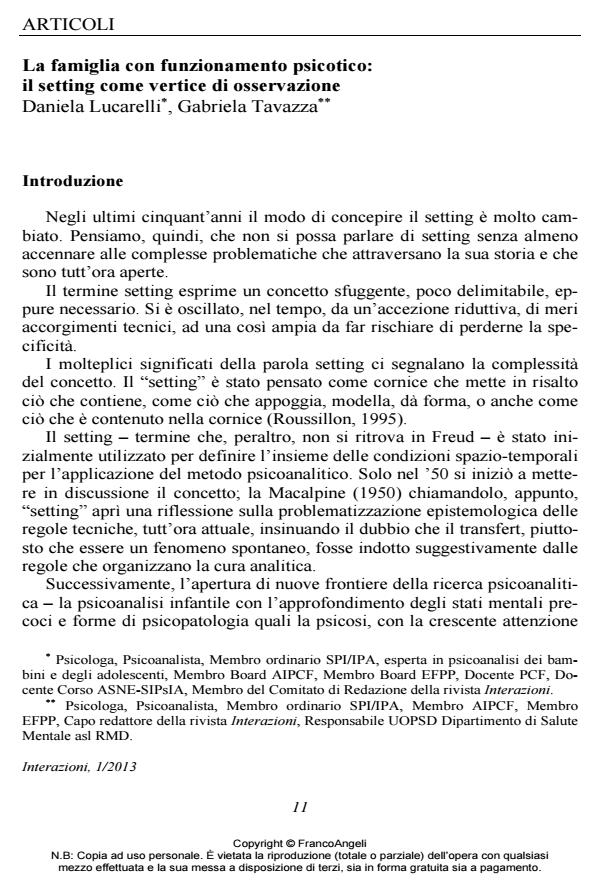Families with psychotic functioning. The setting as observation point
Journal title INTERAZIONI
Author/s Daniela Lucarelli, Gabriela Tavazza
Publishing Year 2013 Issue 2013/1
Language Italian Pages 16 P. 11-26 File size 500 KB
DOI 10.3280/INT2013-001002
DOI is like a bar code for intellectual property: to have more infomation
click here
Below, you can see the article first page
If you want to buy this article in PDF format, you can do it, following the instructions to buy download credits

FrancoAngeli is member of Publishers International Linking Association, Inc (PILA), a not-for-profit association which run the CrossRef service enabling links to and from online scholarly content.
The Authors present a reflection on the use of the setting in the psychotherapeutic treatment of families, paying specific attention to psychotically transacting families. After a brief theoretical explanation of the development of the concept of setting, they dwell on the conceptualizations of the analytical setting that they consider most relevant and original for dealing with the clinical situation presented, such as those of Winnicott, Bleger, Searles, and Kaës. The authors suggest that the setting should be reliable and regular, especially in the case of regressed patients, in order to favour the construction of a "facilitating environment". They then present some clinical material with an unusual use of the setting that can be considered the expression of the analyst’s mental activity while listening to the patients’ needs.
Keywords: Setting, families, changes in setting, analyst’s mental function.
- Bleger J. (1967). Psicoanalisi del setting psicoanalitico. In Bleger J., Simbiosi e ambiguità. Loreto: Lauretana, 1992, pp. 285-300.
- Bollas Ch. (1987). Usi espressivi del controtransfert. In Bollas Ch., L’ombra dell’oggetto. Psicoanalisi del conosciuto non pensato. Milano: Cortina, 1989.
- Donnet J.L. (2001). De la règle fondamentale à la situation analysante. Int. J. Psychoanal., 82, 1: 129-140.
- Eiguer A. (2004). L’inconscient de la maison. Paris: Dunod.
- Gaddini A., Riefolo G. (2008). Transfert verso il setting e processo analitico. In Ferruta A. (a cura di), I Transfert. Cambiamenti nella pratica clinica. Roma: Borla.
- Kaës R. (2007). Un singolare plurale. Roma: Borla.
- Macalpine I. (1950). The development of the transference. Psychoanal. Quart., 19: 501-539.
- Pellizzari G. (2006). Il concetto psicoanalitico di “setting”. AeP. Adolescenza e Psicoanalisi, 1: 21-35.
- Racamier P.C. (1980). Les schizophrènes. Paris: Payot (trad.it.: Gli schizofrenici. Milano: Cortina, 1983).
- Ruffiot A., Eiguer A. et al. (1981). La terapia familiare psicoanalitica. Roma: Borla.
- Roussillon R. (1995). Logiques et archéologiques du cadre psychanalytique. Paris:
- PUF (trad. it.: Il setting psicoanalitico. Roma: Borla, 1997).
- Searles H.F. (1960). L’ambiente non umano nello sviluppo normale e nella schizofrenia. Torino: Einaudi, 2004.
- Winnicott D.W. (1955). Gli aspetti metapsicologici e clinici della regressione nell’ambito della situazione analitica. In Winnicott D.W., Dalla pediatria alla Psicoanalisi. Firenze: Martinelli, 1975, p. 332).
- Winnicott D.W. (1961). La teoria del rapporto infante-genitore. In Winnicott D.W., Sviluppo affettivo e ambiente. Roma: Armando, 1970.
- Winnicott D.W. (1963). La paura del crollo. In Winnicott D.W., Esplorazioni psicoanalitiche. Milano: Cortina, 1995, p. 105.
- Winnicott D.W. (1953). Oggetti transizionali e fenomeni transizionali. In Winnicott D.W., Dalla Pediatria alla Psicoanalisi. Firenze: Martinelli, 1975, pp. 275-290.
Daniela Lucarelli, Gabriela Tavazza, La famiglia con funzionamento psicotico: il setting come vertice di osservazione in "INTERAZIONI" 1/2013, pp 11-26, DOI: 10.3280/INT2013-001002